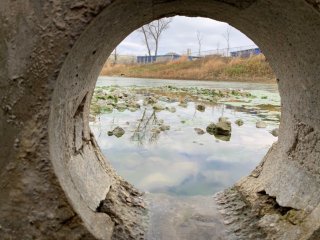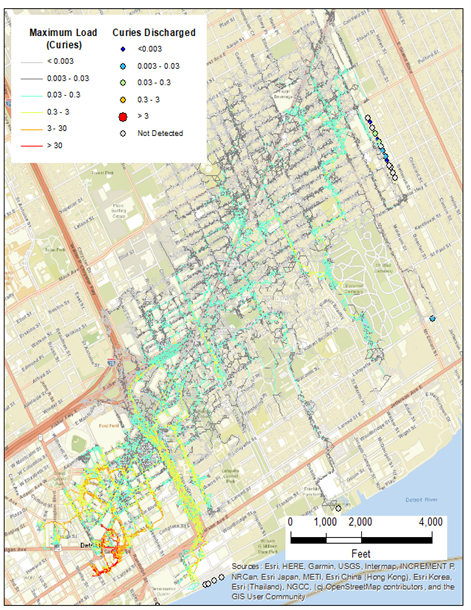Summary of Radiological Stormwater Modeling Research
Studies to understand the transport of contamination in stormwater and inform decisions following a radiological disaster

After the Chernobyl nuclear disaster, stormwater played a role in transport of radionuclides into the natural and built environment. Rain transported radioactive materials from roofs, leading to high concentrations of cesium (137Cs) around houses; wash off from roads caused secondary contamination of sewage systems/sludge storage areas; and decontamination activities included watering streets to move radionuclides into the sewer system.1 In some locations, cesium contamination remained in stormwater runoff from streets for up to seven years.2
After the Fukushima nuclear disaster, periods of high rainfall mobilized 137Cs associated with soil particles, and responders used hydrogeological maps to assess mobilization pathways and recontamination routes when planning decontamination.3
EPA conducts research to aid in the response to and recovery from radiological disasters. EPA is leading stormwater modeling studies that investigate how to simulate transport of radiological contamination in urban stormwater. This has resulted in several publications and an active research portfolio described in more detail below. Together, this ongoing body of work can be leveraged to make more informed decisions after a radiological disaster.
Publications
Modeling Workshop Report
EPA hosted a Radiological Stormwater Modeling Workshop in July 2022. The report below documents the materials presented at the event and a summary of the discussion. The report also synthesizes the content of the workshop into a checklist for the state and local stormwater community to prepare for and execute stormwater modeling projects that help track the spread of radiological contamination after an incident. The information is intended for use by a wide range of stakeholders including, but not limited to stormwater practitioners, emergency responders, and emergency planners.
- EPA Report: Radiological Stormwater Modeling Workshop: Modeling Checklist, Workshop Notes & Materials
Model Reviews
Stormwater modeling software can offer decision makers insights on where to focus sampling and decontamination efforts based on transport after rainfall events. While a wide variety of stormwater tools are actively used in the urban planning and regulatory sectors for flood water control and water quality management, the use of water modeling tools during emergency response and recovery is relatively rare compared to atmospheric modeling.
Existing water modeling tools are often sub-sector specific, and most need modification from their original formats to serve the needs of the radiological emergency response and remediation community. The following two publications outline the unique needs for stormwater models when used in emergency response and provide one-page summaries of 26 common models:

- Journal Publication: Urban Fate and Transport Modeling of Contaminants: The Unique Needs of Emergency Response and the Potential for Adapting Existing Models
- EPA Report: Survey and Assessment of Fate and Transport Models for Use Following a Wide-Area Urban Release to Inform Mapping, Characterization, and Site Clearance
Model Construction
There are unique aspects required to develop and adapt a stormwater model to support radiological remediation actions such as sampling, waste staging, and installation of treatment technologies. EPA researchers have demonstrated the model construction process for a 2D overland flow model in a case study involving a hypothetical dirty bomb detonation (Figure 1). The paper below discusses considerations for modeling non-traditional pollution, including selecting and testing various wash off parameters for 137Cs.
In partnership with local utilities and academia, EPA researchers have also modified two combined sewer overflow models to contain finer scale components that facilitate higher resolution modeling of surface transport of 137Cs. These models are used to support ongoing research studies that may better inform incident support and are available for use in tabletop training exercises.
- Journal Publication: Modeling radionuclide transport in urban overland flow: a case study
- Technical Summary: Stormwater Modeling Response to a Wide Area Radiological Dispersal Device Incident
Stormwater Emergency Response Framework
EPA researchers recognize that detailed stormwater models take time to develop for any particular site. Still, many web resources are publicly available to assist in visualizing stormwater runoff flow paths, and simple calculations may be utilized to estimate peak flows and storage volumes necessary to respond to imminent precipitation events.
- Journal Publication: Emergency response to stormwater contamination: A framework for containment and treatment
Ongoing Research
EPA researchers are leading work in the following areas related to radiological fate and transport in stormwater:
- Development of stormwater modeling tabletop exercises
- Research in the impact of model structure (e.g., 1D vs. 2D vs. dual drainage modeling) on spread of contamination in simulations
- Development of modeling scripts to optimize resource placement (e.g., inlet seals, inflatable dams) to stop the spread of contamination
1Environmental consequences of the Chernobyl accident and their remediation : twenty years of experience / report of the Chernobyl Forum Expert Group ‘Environment’. — Vienna : International Atomic Energy Agency, 2006.
2U.S. EPA. Particle Transport of Radionuclides Following a Radiological Incident. U.S. Environmental Protection Agency, Washington, DC, EPA/600/R-15/113, 2015.
3JAEA Model project report (Remediation of Contaminated Areas in the Aftermath of the Accident at the Fukushima Daiichi Nuclear Power Plant: Overview, Analysis and Lessons Learned Volume 1: A Report on the “Decontamination Pilot Project” Fukushima Environmental Safety Center, Sector of Fukushima Research and Development Japan Atomic Energy Agency Sakae, Fukushima 960-8031, Japan).
